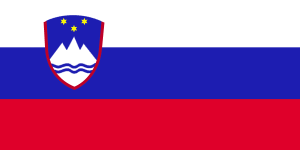Difference Between Slovenia and Slovakia

Slovenia Flag
Introduction
In the early 1990s, political changes in Europe resulted in the creation of two new nations: Slovenia and Slovakia. Both of these nations were formed from larger nations which disintegrated to form smaller states in central and southern Europe. Slovakia arose from the dissolution of Czechoslovakia, while Slovenia came into being after Yugoslavia broke into seven separate states. Due to their almost identical names, many people tend to confuse Slovakia with Slovenia. However, the two nations have numerous cultural, historical, and geographical differences.
Differences Between Slovakia and Slovenia
While Slovakia’s separation from the Czech Republic was not marked by conflict, Slovenia’s creation provoked civil strife within the Yugoslav Federation. While both nations are situated in Central Europe, Slovakia was created in January 1, 1993, while Slovenia was created on June 25, 1991 (Harris, 2002). The capital city of Slovakia is Bratislava, and the nation has a population of 5.4 million. On the other hand, the capital city of Slovenia is Ljubljana, and this nation has a population of 2.5 million (Harris, 2002). While Slovakia is landlocked, Slovenia is adjacent to the Adriatic Sea. In Slovakia, the Slovak Crown or Koruna was the official currency until the nation accepted the Euro in 2008, while in Slovenia, the Euro supplanted the Tolar as the nation’s official currency in 2007 (Office of The Historian, 2013).
The citizens of Slovakia and Slovenia yearned for independence long before the 1990s, but had different histories that resulted in their emergence as sovereign nations. Slovakia’s citizens had expected to form an independent nation at the end of World War II. This was not to be, as Communism influenced political developments in the nation in 1948. In 1968, the grip of communism was further strengthened when the USSR invaded Czechoslovakia, and remained there for the next two decades (Teich, Kováč, & Brown, 2011).
In 1989, the collapse of the USSR did not just result in the fall of the Berlin Wall, but also ended communist totalitarianism in Czechoslovakia (Teich, Kováč, & Brown, 2011). In 1993, the Slovaks and the Czechs decided to peacefully effect a state division that would make each ethnic group a sovereign nation in its own right. This political development went unopposed by the rest of the world, as Slovakia became a member of NATO and the EU in 2004, and a member of the Schengen in 2007, before embracing the Euro in 2009 (Teich, Kováč, & Brown, 2011).
Slovenia also fell to socialist influences soon after the Second World War. When the downfall of the USSR in 1989 eliminated the grip of communism in Yugoslavia, the Slovene parliament voted to secede from the Yugoslav federation (Office of The Historian, 2013). A year later, Milan Kucan was voted president in Slovenia’s primary multi-party elections. The secession of Slovenia was not accepted by the Yugoslav Federation, and its army soon moved into Slovenia to quell this act which was perceived as rebellion. Brokers from the European Union finally convinced the Yugoslav army to withdraw after the number of casualties from the conflict rose to more than 100.
However, thousands of citizens who lived in Slovenia were left without health, education, and welfare services after Slovenia seceded from the Yugoslav Federation. Even though Slovakia’s capital, Bratislava, is wealthier than Slovenia’s Ljubljana, the rest of Slovenia is considerably more economically stable than the rest of Slovakia. In addition, Slovenia has a stronger economy than most of Yugoslavia’s former member states like Kosovo and Macedonia (Office of The Historian, 2013).
Conclusion
Slovakia and Slovenia are different sovereign nations that acquired their independence in the 1990s. Both nations were former member states of larger nations, and experienced different historical events that led to their formation. While Slovakia peacefully broke away from Czechoslovakia in 1993, Slovenia’s secession from the Yugoslav Federation was marked by conflict. Today, both nations are members of the EU, but retain different political systems.
- The Differences between Socialism and National Socialism - April 8, 2016
- The Differences Between The Pharisees and Sadducees - April 8, 2016
- The Difference Between The Hindu Calendar and The Gregorian Calendar - April 8, 2016
Search DifferenceBetween.net :
Leave a Response
References :
[0]Harris, E. (2002). Nationalism and Democratization: Politics of Slovakia and Slovenia. New York: Ashgate Pub Ltd. Retrieved from https://books.google.co.ke/books/about/Nationalism_and_Democratisation.html?id=KG4iAQAAIAAJ&redir_esc=y
[1]Office of The Historian. (2013, Oct. 31). The Break-Up of Yugoslavia, 1990-1992. US Department of State. Retrieved from https://history.state.gov/milestones/1989-1992/breakup-yugoslavia
[2] Teich, M., Kováč, D., & Brown, M. D. (2011). Slovakia in History. Cambridge: Cambridge University Press. Retrieved from https://books.google.co.ke/books?id=jrC1HFgjJxsC&pg=PA149&lpg=PA149&dq=government+articles+on+the+formation+of+Slovakia&source=bl&ots=JdyfQzbO93&sig=tvzLYrXVa7x2Ywd0xbYfllBejtc&hl=en&sa=X&redir_esc=y#v=onepage&q=government%20articles%20on%20the%20formation%20of%20Slovakia&f=false
